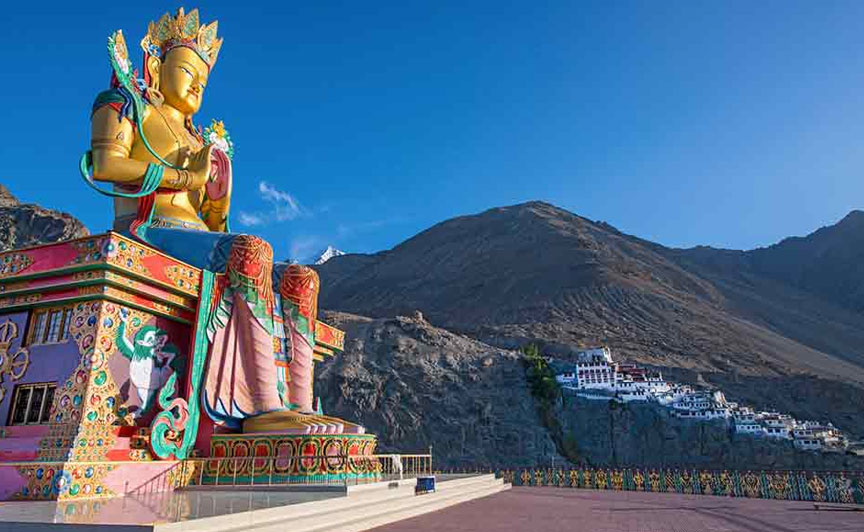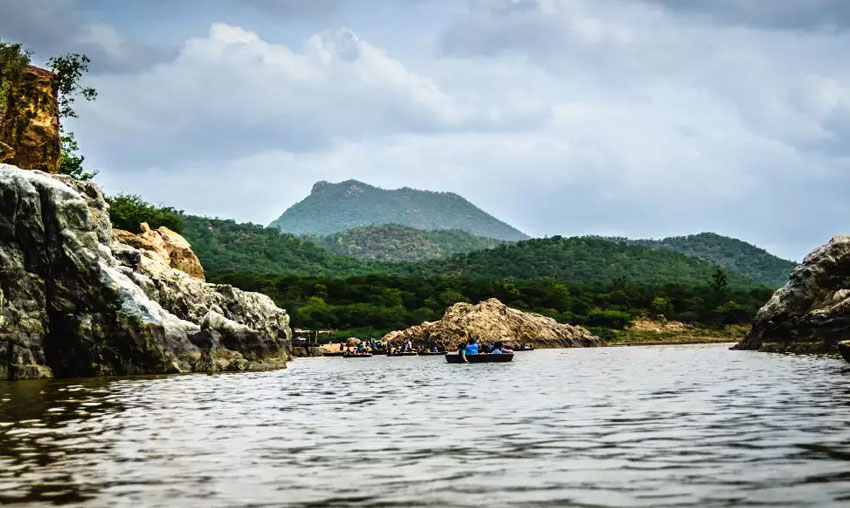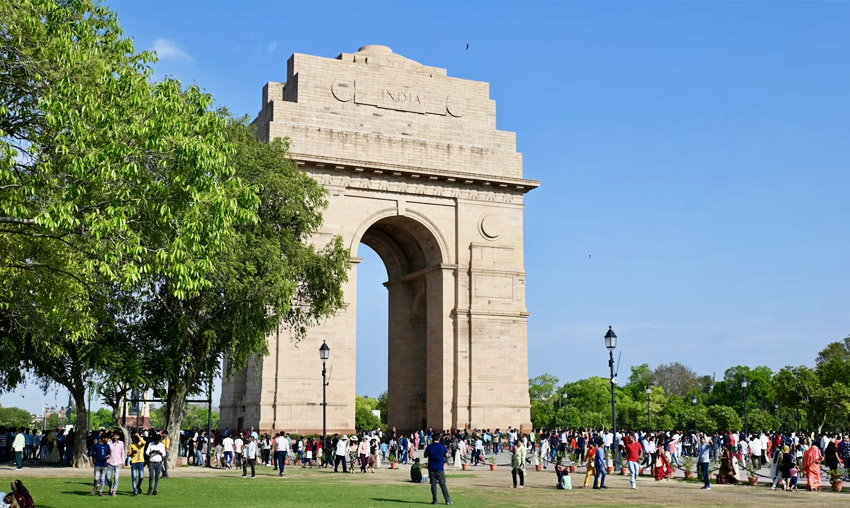October 15, 2024
10 Popular Buddhist Temples & Monasteries to Visit in India
India, a country with a rich spiritual heritage, is home to the majority of the greatest Buddhist temples in the world. India’s Buddhist temples provide a fascinating journey through the country’s rich religious and cultural legacy for those seeking calm and awakening. Holy sites around the world are not only stunning architectural works but also thriving centres of prayer, knowledge, and centuries-old customs.
This Buddhist temple, which doubles as a place of worship, offers a deep sense of understanding and tranquilly to those who seek it. Every holy location, from the first old Bihar ruin to the tranquil Himachal Pradesh environment, tells a different tale of its architectural beauty and devotion. Seeing these holy sites offers a firsthand look at the Buddhist concept and the vast diversity of Indian culture, and it also acts as a time travel experience.
Here are top 10 Buddhist temples to visit in India including the monasteries: –
- Mahabodhi Temple Bihar
- Mahaparinirvana Temple UP
- Namgyal Monastery Himachal
- Tawang Monastery Arunachal
- Tabo Monastery, Himachal Pradesh
- Rumtek Monastery, Sikkim
- Wat Thai Temple, Kushinagar UP
- Hemis Monastery Ladakh
- Ghoom Monastery, Darjeeling
- Spituk Monastery Ladakh
Mahabodhi Temple Bihar
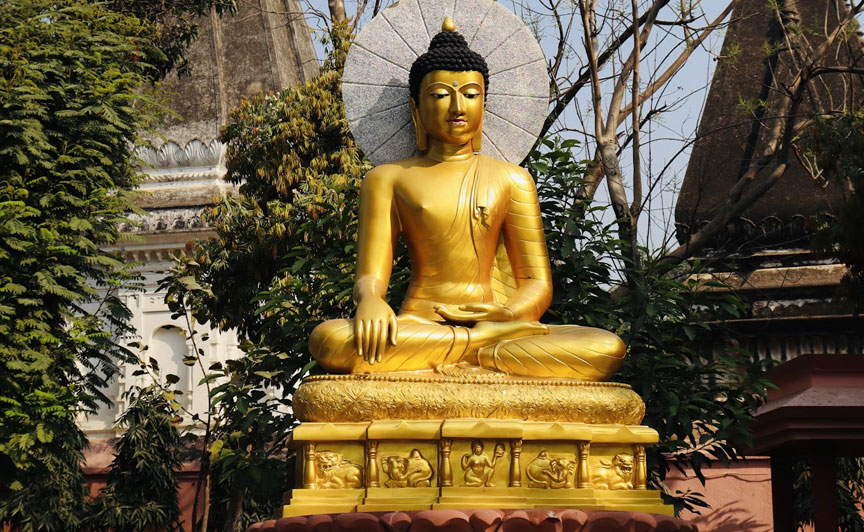
The Mahabodhi Temple, a well-known Buddha temple in India and a rising emblem of Buddhism, represents the exact location where Siddhartha Gautama attained enlightenment and became the Buddha around 2,500 years ago. Situated in Bodh Gaya, one of the most esteemed pilgrimage sites for Buddhists worldwide, is this UNESCO World Heritage site. Emporer Ashoka, who later converted to Buddhism, built the first shrine here in the third century BCE. The current structure, which was built in the fifth and sixth centuries CE, is a remarkable example of mediaeval Indian brick construction with a 55-meter-tall rising pyramidal tower.
With several smaller statues and stupas that each convey a tale of commitment and dedication, as well as beautifully landscaped gardens, the temple complex is a tranquil paradise. The well-known Bodhi Tree, which was a descendant of the original tree where the Lord Buddha used to meditate, is situated in the middle of the compound. A visit to the Mahabodhi temple combines learning about culture and history with religious studies.
Mahaparinirvana Temple UP
The Mahaparinirvana temple in Kushinagar, Uttar Pradesh, is a major Buddhist pilgrimage site. Around 482 BCE, Siddhartha Gautam, also known as Buddha, is said to have reached Mahaparinirvana, or ultimate freedom, at this temple. This hallowed location is well known for being connected to the Buddha’s passing and final ascension into Nirvana. A massive lying Buddha statue that is part of the Temple complex is one of the most well-known iconic depictions of the Buddha in his last moments. The Buddha is seated peacefully on his right side in this statue, which is around 20 feet long and represents his release from the cycle of birth and reincarnation.
The temple’s construction, which emphasises historical and spiritual study, represents the rich tradition of Buddhist art. The main shrine is surrounded by other stupas and monasteries, including the Rambhar Stupa, which is thought to have been the location of Buddha’s cremation. This site is a must-see for Buddhists in India because it also features writings and crafts from the early Buddhist tradition.
Namgyal Monastery Himachal
The greatest and most important centre of Tibetan Buddhism is Namgyal Monastery, the monastery of the 14th Dalai Lama, which is situated in McLeod Ganj, Himachal Pradesh. The monastery was founded in 1575 by the third Dalai Lama, and it was rebuilt in India when the Dalai Lama fled due to the Tibetan uprising in 1959. The monastery is a significant centre for Buddhist education, cultural preservation, meditation, and prayer, and it is situated in the tranquil hills of Dharamshala. In addition to serving as a religious institution, it serves as a symbol of Tibetan heritage and upholds the teachings, traditions, and practices of Tibetan Buddhism in exile.
The Namgyal Monastery is a thriving institution that is crucial to preserving the Tibetan way of life. Monks at the monastery study Buddhist books, pray, meditate, and perform rituals; some of them get support for the Dalai Lama’s spiritual endeavours. Both civilians and monks can enter the monastery, which offers a peaceful and serene setting for meditation for people interested in learning about Tibetan Buddhism.
Tawang Monastery Arunachal
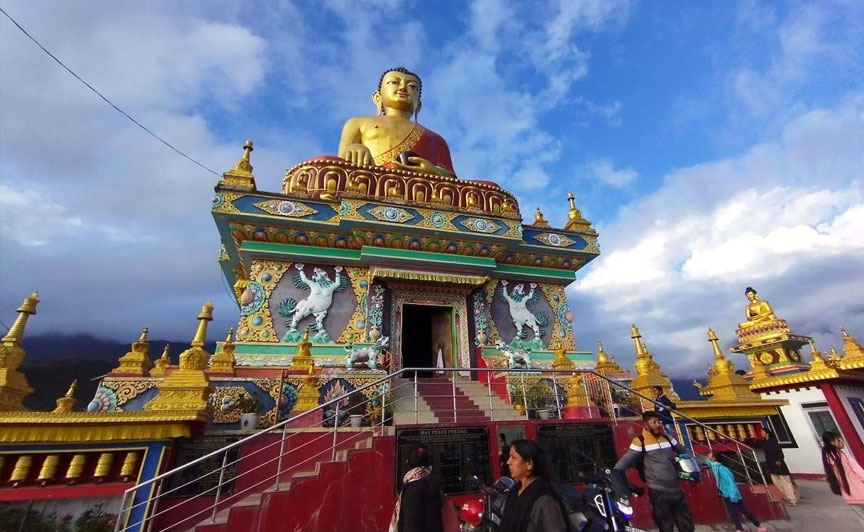
Tawang Monastery, situated in the northwest of the Indian state of Arunachal Pradesh, is one of the country’s most revered and ancient sites. The largest monastery in India and the second largest in the world is situated near Potala Pala in Lhasa, in the picturesque town of Tawang, at a height of 10,000 feet. This monastery, founded in 1680–1681, by Merak Lama Lodre Gyatso, is a significant hub for the preservation and spread of Tibetan Buddhist culture. It is also a component of Tibetan Buddhism’s Gelupa branch. This monastery serves as a place of worship and education for more than 300 monks who are living and studying Buddhism there.
Because of its broad courtyards and tall walls that resemble a fort, the monastery’s architecture is distinctive. The three-story building’s focal point is a golden statue of Lord Buddha that is 28 feet tall. It also has a library with ancient manuscripts and a majestic, gratifying hall. The stunning views of the surrounding Himayalan hills from the monastery are truly stunning.
Tabo Monastery, Himachal Pradesh
Tabo Monastery, situated in the isolated Spiti Valley of Himachal Pradesh, is one of the oldest and holiest Buddhist monasteries in India. The Tabo monastery, a well-known Buddhist monastery in India, was established in 996 AD by the Buddhist monarch Yeshe-O of the Guge family in the western Himalayas. It is renowned for its great spiritual, social, and historical significance. The monastery is well known for its historical art that blends Tibetan and Indian styles, and because of its exquisite paintings, it is frequently referred to as the “Ajanta of the Himalayas.” In contrast to a number of other monasteries situated on hilltops, Tabo, which is situated on the valley level, is surrounded by arid, rocky landscape that exudes a sense of mystery and tranquilly.
The monastery’s entire edifice is made up of the nine temples, many stupas, and monks’ meditation chambers. The major temple, Tsuglagkhang, is devoted to exquisite sculpture, exquisite wall paintings, and historical documents that date back more than a millennium.
Rumtek Monastery, Sikkim
Rumtek Monastery, a short drive from Gangtok in the Indian state of Sikkim, is well-known for its significance in Tibetan Buddhism. Built by the ninth Karmapa in the sixteenth century, it is the centre of Karma Kagyu tradition and is located far from Tibet. Replicating the actual monastery in Tibet, Tsurphu Monastery is well-known for its exquisite architecture. Its lush surroundings provide a serene setting for rest and devotion. There are a few monks who live in the monastery and participate in daily rituals, teachings, and prayers. The Golden Stupa, a well-known destination that draws pilgrims and visitors from all over the world, is home to the remains of the sixteenth Karmapa.
Furthermore, Rumtek hosts a range of religious gatherings. The Tibetan New Year, which is marked by festivities and mask dances, is one of the busiest of them. This place is a must-visit for those who want to learn more about Sikkim’s rich Buddhist past because of its serene surroundings, historical significance, and fascinating new cultural events.
Wat Thai Temple, Kushinagar UP
Thai architectural and cultural features can be seen at the well-known Buddhist temple Wat Thai Temple in Khushinagar, Uttar Pradesh. The temple is a well-known Buddhist temple in India and was constructed in the 1990s to commemorate the Thai King’s visit to Khushinagar. It is a testament to the close and profound cultural and spiritual ties that exist between Thailand and India. As one of the four major pilgrimage sites in Buddhism, Khushinagar is thought to be the place where Lord Buddha experienced Mahaparinirvana, or the final awakening. The temple’s architecture deftly combines Thai and Indian architectural elements with a golden spire, elaborate carvings, and statues that symbolise the life and teachings of Buddhism.
The beautiful surroundings of Wat Thai Temple provide worshippers and tourists with a picture-perfect paradise. A large meditation hall, verdant gardens, and a variety of Buddhist sculptures combine to create a calm atmosphere that is ideal for prayer and reflection.
Hemis Monastery Ladakh
Located in the isolated and picturesque Ladakh region, Hemis Monastery is one of the largest and most well-known monasteries in India and a popular destination for Buddhist tourists. Situated amidst the untamed splendour of the Indus valley and the untamed landscape, this 17th-century Tibetan Buddhist monastery is associated with the Drukpa lineage, a well-known and prestigious establishment within Vijayrana Buddhism. With the support of King Senggee Namgyal, the first state, Satsang Rapsa Nawang Gyatso, constructed Hemis Monastery in 1672. In terms of history, religion, and culture, it is very significant. The amazing architecture of the monastery is highlighted by its large prayer hall, exquisitely painted walls, display of Buddhist deities and mandalas, and an extensive collection of old scriptures, thangkas, and sculptures.
The main draw for visitors to Hemis is the yearly Hemis festival, a colourful two-day event held in June or July to honour the legacy of the well-known Indian saint, Guru Padmasambhava, who is credited with bringing Buddhism to Tibet. Both locals and tourists gather in great numbers at the Hemis monastery to celebrate this event.
Ghoom Monastery, Darjeeling
One of the most famous and ancient Tibetan Buddhist monasteries is Ghoom Monastery, also called Yiga Choeling Monaster, located in Darjeeling, West Bengal. This location, which is around 7,500 feet above sea level, provides breathtaking vistas and a picturesque setting against the spectacular Himalayan range. The Ghoom monastery was established in 1850 by the Mongolian monk Lama Sherab Gytso and is affiliated with the Gelupa “Yellow Het” sect, which is the Dalai Lama’s school of Tibetan Buddhism. The most noticeable feature of the monastery is the statue of Maitreya Buddha, the Buddha of the future, which stands fifteen feet tall and is exquisitely adorned with priceless stone and clothing.
The monastery’s walls are adorned with thangkas, traditional Tibetan paintings that depict various facets of Buddhist mythology and values. Through their frequent prayers, meditations, and rituals, the monks who live here contribute to the heavenly spirit that permeates the monastery.
Spituk Monastery Ladakh
Spituk Monastery, also known as Spituk Gompa, is a well-known Buddhist monastery in Ladakh, India, close to Leh. The Gelugpa order finally seized control of the monastery, which had previously been a part of the Kadampa school of Tibetan Buddhism. Od-de, the brother of Lha Lama Changchub Od, founded it in the eleventh century. Perched on a hill, Spituk provides breathtaking views of the Indus River and the surrounding untamed terrain. The old thangkas, sculptures, and imposing representations of Mahakal, a furious deity worshipped during the January Gustor Festival, are the monastery’s most well-known features.
In addition to housing more than 100 monks, the monastery has a small exhibition featuring religious objects, weapons, and historical masks. A visit to Spituk monastery is essential for visitors who enjoy learning about Ladakh’s rich cultural legacy because of its breathtaking surroundings, cultural relevance, and profound religious significance.
Latest Blogs
-
Best Tourist Places to Visit near Bangalore Within 100 kms
March 25, 2025
-
Pet Friendly Luxury Resorts near Mumbai for Family
March 22, 2025
-
Pet friendly Resorts near Delhi within 100 kms
March 18, 2025
-
Best Tourist Places to Visit near Delhi
March 15, 2025
-
Top 10 bikes for touring in India
March 12, 2025
-
12 Jyotirlinga Name and Place – Timing & How to reach
February 26, 2025
-
You must opt-in Things to Do when traveling to India
September 27, 2024
-
Adventure Awaits: Exploring Kochi’s Exciting Sports Activities
September 25, 2024
-
Unleash Your Adventurous Spirit with Leh Ladakh Bike Tour Packages
September 19, 2024
-
10 Best Weekend Resorts for a Quick Escape from Delhi
